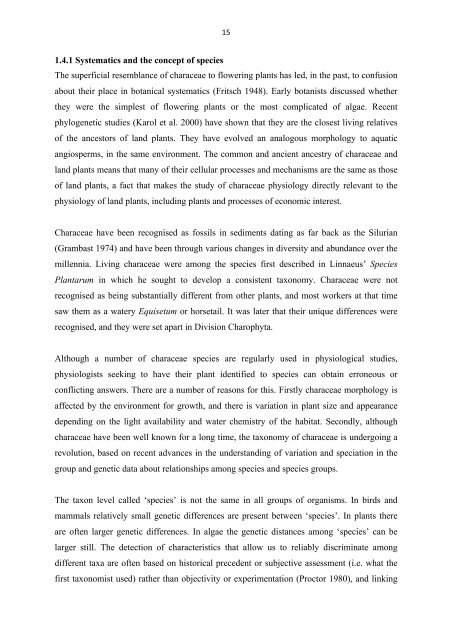Chapter 1: The Characeae Plant
Chapter 1: The Characeae Plant
Chapter 1: The Characeae Plant
Create successful ePaper yourself
Turn your PDF publications into a flip-book with our unique Google optimized e-Paper software.
15 <br />
1.4.1 Systematics and the concept of species<br />
<strong>The</strong> superficial resemblance of characeae to flowering plants has led, in the past, to confusion<br />
about their place in botanical systematics (Fritsch 1948). Early botanists discussed whether<br />
they were the simplest of flowering plants or the most complicated of algae. Recent<br />
phylogenetic studies (Karol et al. 2000) have shown that they are the closest living relatives<br />
of the ancestors of land plants. <strong>The</strong>y have evolved an analogous morphology to aquatic<br />
angiosperms, in the same environment. <strong>The</strong> common and ancient ancestry of characeae and<br />
land plants means that many of their cellular processes and mechanisms are the same as those<br />
of land plants, a fact that makes the study of characeae physiology directly relevant to the<br />
physiology of land plants, including plants and processes of economic interest.<br />
<strong>Characeae</strong> have been recognised as fossils in sediments dating as far back as the Silurian<br />
(Grambast 1974) and have been through various changes in diversity and abundance over the<br />
millennia. Living characeae were among the species first described in Linnaeus’ Species<br />
<strong>Plant</strong>arum in which he sought to develop a consistent taxonomy. <strong>Characeae</strong> were not<br />
recognised as being substantially different from other plants, and most workers at that time<br />
saw them as a watery Equisetum or horsetail. It was later that their unique differences were<br />
recognised, and they were set apart in Division Charophyta.<br />
Although a number of characeae species are regularly used in physiological studies,<br />
physiologists seeking to have their plant identified to species can obtain erroneous or<br />
conflicting answers. <strong>The</strong>re are a number of reasons for this. Firstly characeae morphology is<br />
affected by the environment for growth, and there is variation in plant size and appearance<br />
depending on the light availability and water chemistry of the habitat. Secondly, although<br />
characeae have been well known for a long time, the taxonomy of characeae is undergoing a<br />
revolution, based on recent advances in the understanding of variation and speciation in the<br />
group and genetic data about relationships among species and species groups.<br />
<strong>The</strong> taxon level called ‘species’ is not the same in all groups of organisms. In birds and<br />
mammals relatively small genetic differences are present between ‘species’. In plants there<br />
are often larger genetic differences. In algae the genetic distances among ‘species’ can be<br />
larger still. <strong>The</strong> detection of characteristics that allow us to reliably discriminate among<br />
different taxa are often based on historical precedent or subjective assessment (i.e. what the<br />
first taxonomist used) rather than objectivity or experimentation (Proctor 1980), and linking
















